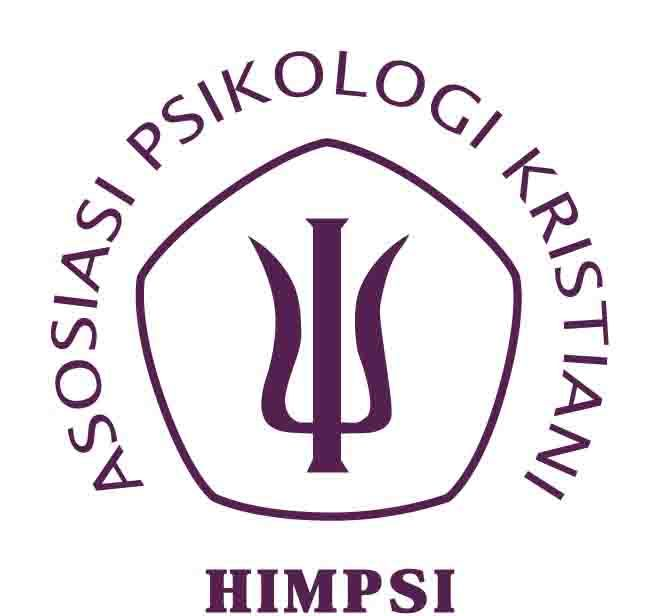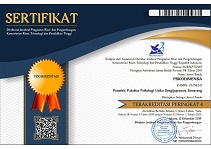Adaptasi Skala Problematic Internet Use Questionnaire (PIUQ) Versi Indonesia
Abstract
Problematic Internet Use merupakan perilaku penggunaan internet yang menyebabkan berbagai masalah bagi penggunanya. Salah satu skala yang dapat digunakan untuk mengukur penggunaan internet adalah Problematic Internet Use Questionnaire (PIUQ) yang dikembangkan oleh Demetrovics et al., (2008). Kendala bahasa dan budaya menjadi salah satu faktor yang memengaruhi karakteristik psikometrik dari alat tes. Tujuan dari penelitian ini adalah (1) mengadaptasi PIUQ sesuai dengan konteks Indonesia, (2) melakukan konfirmasi faktor dan reliabilitas. Penelitian ini melibatkan sebanyak 155 orang warga negara Indonesia dengan rentang usia 18 hingga 25 tahun yang termasuk kategori dewasa awal. Hasil penelitian menunjukkan bahwa PIUQ versi Indonesia memiliki nilai reliabilitas yang baik yaitu sebesar 0,850 secara keseluruhan; 0,724; 0,637; dan 0,711 untuk setiap dimensi obsession, neglect, dan control disorder. Hasil confirmatory factor analysis (CFA) diperoleh nilai (325,462; N = 155) = 2,466; GFI= 0,951; CFI= 0,931; RMSEA= 0,098; SRMR= 0,098. Dapat disimpulkan bahwa skala Problematic Internet Use Questionnaire (PIUQ) versi Indonesia dengan model 3 faktor dapat dikatakan fit sesuai dengan skala aslinya.
Keywords
Full Text:
PDF (Bahasa Indonesia)References
Aivali, P., Efthymiou, V., Tsitsika, A. K., Vlachakis, D., Chrousos, G. P., Kanaka-Gantenbein, C., & Bacopoulou, F. (2021). Validation of the Greek
version of the Problematic Internet Use Questionnaire - Short Form (PIUQ-SF-6). EMBnet.Journal, 26(1), e978.
https://doi.org/10.14806/ej.26.1.978
Andangsari, E. W., Djunaidi, A., Fitriana, E., & Harding, D. (2019). Indonesia Problematic Internet Use Scale. Journal of Physics: Conference
Series, 1175(1). https://doi.org/10.1088/1742-6596/1175/1/012239
Ann Liebert, M., & Young, K. S. (1998). Internet Addiction: The Emergence of a New Clinical Disorder. In CyberPsychology & Behavior (Vol. 1,
Issue 3).
APJII. (2022). Survei Profil Internet Indonesia 2022. Asosiasi penyelenggara jasa internet Indonesia, 2022. https://apjii.or.id/gudang-data/hasil-
survei
Beaton, D. E., Bombardier, C., Guillemin, F., & Ferraz, M. B. (2000). Guidelines for the Process of Cross-Cultural Adaptation of Self-Report
Measures. In SPINE (Vol. 25, Issue 24).
Caplan, S. E. (2002). Problematic Internet use and psychosocial well-being: Development of a theory-based cognitive-behavioral measurement
instrument. Computers in Human Behavior, 18(5), 553–575. https://doi.org/10.1016/S0747-5632(02)00004-3
Demetrovics, Z., & Király, O. (2019). Psychometric evaluation of the nine-item problematic Internet use questionnaire (PIUQ-9) in nine European
samples of internet users. Frontiers in Psychiatry, 10(MAR). https://doi.org/10.3389/fpsyt.2019.00136
Demetrovics, Z., Király, O., Koronczai, B., Griffiths, M. D., Nagygyörgy, K., Elekes, Z., Tamás, D., Kun, B., Kökönyei, G., & Urbán, R. (2016).
Psychometric properties of the Problematic Internet Use Questionnaire Short-Form (PIUQ-SF-6) in a Nationally representative sample of
adolescents. PLoS ONE, 11(8). https://doi.org/10.1371/journal.pone.0159409
Demetrovics, Z., Szeredi, B., & Rózsa, S. (2008). The three-factor model of Internet addiction: The development of the Problematic Internet Use
Questionnaire. Behavior Research Methods, 40(2), 563–574. https://doi.org/10.3758/BRM.40.2.563
Furr, R.M., & Bacharach, V. R. (2022). Psychometrics: An introduction fourth edition. SAGE
Griffiths, M. (2000). Does Internet and Computer “Addiction” Exist? Some Case Study Evidence (Vol. 3, Issue 2). Mary Ann Liebert, Inc.
Hu, L. T., & Bentler, P. M. (1999). Cutoff criteria for fit indexes in covariance structure analysis: Conventional criteria versus new alternatives.
Structural Equation Modeling, 6(1), 1–55. https://doi.org/10.1080/10705519909540118
Holmes-Smith, P. (2001) Introduction to Structural Equation Modeling Using LISREL. ACSPRI Winter Training Program, Perth
Joreskog,K.G.dan D.Sorbom.1996. LISREL8: User’s Reference Guide: SSI, Inc.
Kelley, K. J., & Gruber, E. M. (2010). Psychometric properties of the Problematic Internet Use Questionnaire. Computers in Human Behavior,
(6), 1838–1845. https://doi.org/10.1016/j.chb.2010.07.018
Koronczai, B., Kökönyei, G., Urbán, R., Király, O., Nagygyörgy, K., Felvinczi, K., Griffiths, M. D., Huang, Z., & Demetrovics, Z. (2017). Confirmation
of the Chinese Version of the Problematic Internet Use Questionnaire Short Form (PIUQ-SF). International Journal of Mental Health and
Addiction, 15(1), 191–197. https://doi.org/10.1007/s11469-016-9664-4
Koronczai, B., Urbán, R., Kökönyei, G., Paksi, B., Papp, K., Kun, B., Arnold, P., Kállai, J., & Demetrovics, Z. (2011). Confirmation of the three-factor
model of problematic internet use on off-line adolescent and adult samples. Cyberpsychology, Behavior, and Social Networking, 14(11), 657–
https://doi.org/10.1089/cyber.2010.0345
Laconi, S., Urbán, R., Kaliszewska-Czeremska, K., Kuss, D. J., Gnisci, A., Sergi, I., Barke, A., Jeromin, F., Groth, J., Gamez-Guadix, M., Ozcan, N. K.,
Siomos, K., Floros, G. D., Griffiths, M. D., Demetrovics, Z., & Király, O. (2019). Psychometric evaluation of the nine-item problematic Internet use
questionnaire (PIUQ-9) in nine European samples of internet users. Frontiers in Psychiatry, 10(MAR). https://doi.org/10.3389/fpsyt.2019.00136
Lin, M., & Kim, Y. (2020). The reliability and validity of the 18-item long form and two short forms of the Problematic Internet Use Questionnaire
in three Japanese samples. Addictive Behaviors, 101(April 2019), 105961. https://doi.org/10.1016/j.addbeh.2019.04.019
Nurafifah, N., & Ilmi Hatta, M. (2023). Pengaruh Problematic Internet Use Terhadap Subjective Well-Being Pada Mahasiswa Universitas Islam
Bandung. Bandung Conference Series: Psychology Science, 3(2), 1050–1057. https://doi.org/10.29313/bcsps.v3i2.9493
Opakunle, T., Aloba, O., Opakunle, O., & Eegunranti, B. (2020). Problematic Internet Use Questionnaire-Short Form-6 (PIUQ-SF-6):
Dimensionality, validity, reliability, measurement invariance and mean differences across genders and age categories among Nigerian
adolescents. International Journal of Mental Health, 49(3), 229–246. https://doi.org/10.1080/00207411.2020.1776457
Thatcher, A., & Goolam, S. (2005). Development and psychometric properties of the problematic Internet use questionnaire. South African
Journal of Psychology, 35(4), 793–809. https://doi.org/10.1177/008124630503500410
Urbina, S. (2004). Essentials of Psychological Testing. John Willey & Sons, Inc.
Young, K. S. (1999). Internet addiction: evaluation and treatment. Bmj, 319(Suppl S4), 9910351. https://doi.org/10.1136/sbmj.9910351
DOI: https://doi.org/10.24167/psidim.v22i2.10117
Print ISSN : 1411-6073 | online ISSN : 2579-6321 View My Stats

This work is licensed under a Creative Commons Attribution 4.0 International License.




















